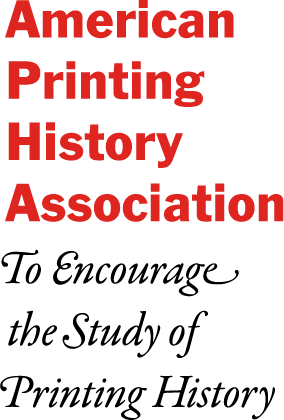Frequently Asked Questions
Please review the following frequently asked questions. If you find that none addresses your query, please write us via the contact form.
| Frequently Asked Questions | Answer |
|---|---|
| How do I advertise in Printing History? | Please visit APHA's Printing History Advertising page. |
| Do I retain copyright to articles I submit to Printing History or the website? | Yes, an author retains copyright of their article throughout the period it is accepted and published by the American Printing History Association. For more, please refer to APHA's Printing History Article Submission Guidelines page. |
| I'm trying to find the name of the printing company my father or ancestor worked for. Can you direct me to any information? | The Library of Congress has a useful online guide on conducting historical company research. Also consider contacting the public library in the relevant city or town. They may have business directories from that era or point you to another resource. |
| I have an old book, pamphlet, or print. Can you help me determine its value? | You can learn more about old books, manuscripts, prints and ephemera by visiting the "Your Old Books" page of the Rare Books and Manuscripts Section (RBMS) of the American Library Association and the "About Antiquarian Books" page of the Antiquarian Booksellers' Association of America (ABAA). To help assess your item's general value, you can search for comparable copies using freely available secondary market resources like Vialibri, Abebooks, Biblio and eBay. Casual online research is a good starting point, but accurate valuation can be complex. Your item's monetary value will depend on several factors, including rarity, condition, provenance, historical and cultural importance, and current market conditions. Consulting experienced dealers and appraisers is often recommended, especially for rare or potentially valuable items. |
| I own some old engraved printing blocks. Are they worth anything? How do I take care of them? | There is a niche market for photoengraved, wood-mounted blocks, often called "cuts", with a larger supply than demand. Their value varies significantly based on material, age, condition, and artistic merit. Antique letterpress blocks with unique designs or historical importance can be quite valuable, ranging from a few dollars to hundreds. Modern linoleum and wood blocks for art prints are generally less expensive, typically selling for a few to several tens of dollars. You'll find many cuts available for sale on eBay. Regarding care and conservation, most cuts and unmounted plates will show nicks and scratches. Copper plates are more corrosion-resistant than those made of magnesium or zinc. If you see a chalky white substance, it indicates magnesium corrosion. While slightly toxic, this can be cleaned, but it means a portion of the image is permanently lost, potentially rendering the cut or plate worthless. |
| I have printing equipment for sale. Where can I find a buyer? | The best options are to post an advertisement with photos and your location on Briar Press and these Facebook groups: Letterpress Sale – Private or Press to Press Letterpress Buy/Sell/Trade - North America Letterpress USA & CA - Buy, Sell, & Trade |
| I would like information on how to clean antique copper, zinc, and wood printing blocks. | Good sources for such information are Briar Press and Letterpress Commons. |
| Where can I find a printer who can make prints from a printing block I own? | There are small business letterpress printers in most cities in developed countries. Good sources for such information are Briar Press and Letterpress Commons. |
| What fonts does the APHA website use? | EB Garamond is used for titles and all other texts. Franklin Gothic is used for navigation and barred headings. For more, please visit APHA's Website Production Notes page. |
